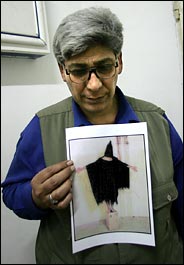 The New York Times keeps claiming some moving-target form of superiority over blogs and new media, and then they go with this:
The New York Times keeps claiming some moving-target form of superiority over blogs and new media, and then they go with this:Oooops.Almost two years later, Ali Shalal Qaissi's wounds are still raw. There is the mangled hand, an old injury that became infected by the shackles chafing his skin. There is the slight limp, made worse by days tied in uncomfortable positions. And most of all, there are the nightmares of his nearly six-month ordeal at Abu Ghraib prison in 2003 and 2004.
The story continues in lurid detail, a searing indictment of the sadistic cruelty of the American armed forces. And Qaissi is described, sympathetically, as a man on a mission: he forgives his American torturers, but wants to prevent similar "atrocities" from occurring in the future. The Times article is titled "Symbol of Abu Ghraib Seeks to Spare Others His Nightmare." It was indeed a gripping story. And, needless to say, one that suited the Times' political agenda.
Just one problem, though: it wasn't true. Qaissi is a hoax.
So the Times got it wrong, in part, because they didn't research their own archives to discover any back story or facts.A front-page article last Saturday profiled Ali Shalal Qaissi, identifying him as the hooded man forced to stand on a box, attached to wires, in a photograph from the Abu Ghraib prison abuse scandal of 2003 and 2004. He was shown holding such a photograph. As an article on Page A1 today makes clear, Mr. Qaissi was not that man.
The Times did not adequately research Mr. Qaissi's insistence that he was the man in the photograph. Mr. Qaissi's account had already been broadcast and printed by other outlets, including PBS and Vanity Fair, without challenge. Lawyers for former prisoners at Abu Ghraib vouched for him. Human rights workers seemed to support his account. The Pentagon, asked for verification, declined to confirm or deny it.
UPDATE: The New York Times Editorial stooges continue to not read their own paper.


No comments:
Post a Comment